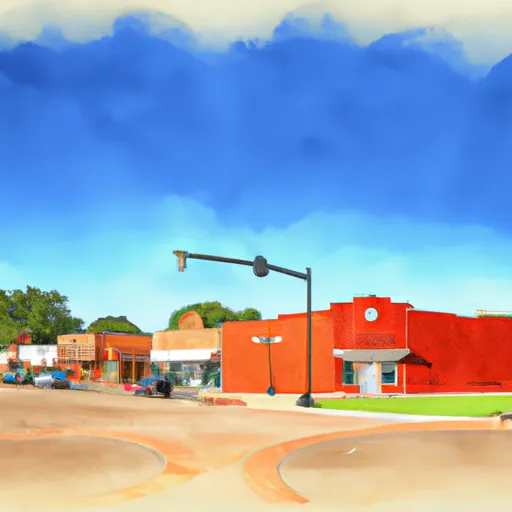-
 Snoflo Premium
Snoflo Premium
Get unlimited access to all our content
With no Ad interruptions! - Start Your Free Trial Login with existing account
Milo
Eden Index
Climate
9.7
•
Recreation
5.7
•
Community
2.4
•
Safeguard
6.5/10

Milo, Oklahoma is a small town located in Bryan County, in the southeastern part of the state. The climate in Milo is considered humid subtropical, characterized by hot, humid summers and mild winters. Summers often experience temperatures reaching the mid-90s Fahrenheit, while winters have average temperatures ranging from the mid-30s to mid-50s Fahrenheit.
Hydrologically, Milo is part of the Red River Basin, which is known for its diverse aquatic ecosystems. The region is home to several rivers, including the Red River and its tributaries. These water bodies provide opportunities for fishing, boating, and water sports.
In terms of outdoor recreation, Milo is surrounded by natural beauty and offers various activities for nature enthusiasts. Outdoor enthusiasts can explore the nearby Tishomingo National Wildlife Refuge, which covers over 16,000 acres and provides opportunities for wildlife viewing, birdwatching, hiking, and hunting. Additionally, the region offers several parks and recreational areas for camping, picnicking, and exploring nature trails.
In conclusion, Milo, Oklahoma, offers a humid subtropical climate, a hydrological connection to the Red River Basin, and numerous outdoor recreation opportunities, making it an attractive destination for nature lovers and outdoor enthusiasts.
What is the Eden Index?
The Snoflo Eden Index serves as a comprehensive rating system for regions, evaluating their desirability through a holistic assessment of climate health, outdoor recreation opportunities, and natural disaster risk, acknowledging the profound impact of these factors on livability and well-being.
Climate Health Indicator (CHI): 9.7
Milo receives approximately
954mm of rain per year,
with humidity levels near 78%
and air temperatures averaging around
18°C.
Milo has a plant hardyness factor of
7, meaning
plants and agriculture in this region tend to thrive during the non-winter months.
By considering the ideal temperature range, reliable water supplies, clean air, and stable seasonal rain or snowpacks, the Climate Health Indicator (CHI) underscores the significance of a healthy climate as the foundation for quality living.
A healthy climate is paramount for ensuring a high quality of life and livability in a region, fostering both physical well-being and environmental harmony. This can be characterized by ideal temperatures, reliable access to water supplies, clean air, and consistent seasonal rain or snowpacks.
Weather Forecast
Streamflow Conditions
Red-Lake Texoma
Area Rivers
Red-Lake Texoma
Snowpack Depths
Red-Lake Texoma
Reservoir Storage Capacity
Red-Lake Texoma
Groundwater Levels
Recreational Opportunity Index (ROI): 5.7
The Recreational Opportunity Index (ROI) recognizes the value of outdoor recreational options, such as parks, hiking trails, camping sites, and fishing spots, while acknowledging that climate plays a pivotal role in ensuring the comfort and consistency of these experiences.
Access to outdoor recreational opportunities, encompassing activities such as parks, hiking, camping, and fishing, is crucial for overall well-being, and the climate plays a pivotal role in enabling and enhancing these experiences, ensuring that individuals can engage in nature-based activities comfortably and consistently.
Camping Areas
| Campground | Campsites | Reservations | Toilets | Showers | Elevation |
|---|---|---|---|---|---|
| Isle du Bois - Roberts Lake State Park | 182 | 685 ft | |||
| Marietta Landing - Lake Murray State Park | None | 765 ft | |||
| Rock Tower - Lake Murray State Park | None | 776 ft | |||
| Lebanon - Lake Texoma | None | 617 ft | |||
| Tipps Point - Lake Murray State Park | None | 755 ft | |||
| Little Elm Park | None | 547 ft | |||
| Martins Landing - Lake Murray State Park | None | 761 ft | |||
| Johnson Branch - Roberts Lake State Park | 163 | 685 ft | |||
| Hickory Creek - Lake Texoma | None | 668 ft | |||
| Buzzards Roost - Lake Murray State Park | None | 764 ft |
Catastrophe Safeguard Index (CSI):
The Catastrophe Safeguard Index (CSI) recognizes that natural disaster risk, encompassing floods, fires, hurricanes, and tornadoes, can drastically affect safety and the overall appeal of an area.
The level of natural disaster risk in a region significantly affects safety and the overall livability, with climate change amplifying these risks by potentially increasing the frequency and intensity of events like floods, fires, hurricanes, and tornadoes, thereby posing substantial challenges to community resilience and well-being.
Community Resilience Indicator (CRI): 2.4
The Community Resilience Indicator (CRI) recognizes that education, healthcare, and socioeconomics are crucial to the well-being of a region. The CRI acknowledges the profound impact of these elements on residents' overall quality of life. By evaluating educational resources, healthcare accessibility, and economic inclusivity, the index captures the essential aspects that contribute to a thriving community, fostering resident satisfaction, equity, and social cohesion.

